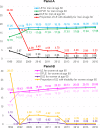Trends in health expectancy at age 60 in Bangladesh from 1996 to 2016
- PMID: 36417472
- PMCID: PMC9683622
- DOI: 10.1371/journal.pone.0278101
Trends in health expectancy at age 60 in Bangladesh from 1996 to 2016
Abstract
Background: Life expectancy (LE) is increasing all over the world, and relying on LE alone is no longer sufficient to identify whether a country is having a healthier population. Examining the increase in LE in relation to health - health expectancy estimation - is advised to ascertain the increase (or decrease) in LE without disability over time. This study examines the trends in health expectancy at age 60 in Bangladesh from 1996 to 2016.
Methods: Mortality information from United Nations and World Health Organization and morbidity information from Bangladesh Bureau of Statistics were combined using the Sullivan method.
Results: With an overall declining trend over the study period and a big drop in disability rates during 2012-2013, the disability rates were observed 1.6-1.7% in 2016. The declining trend in disability may have two-fold implications: (1) among the 98.3% older adults (≥60 years) with no severe/extreme disability, those were in jobs could have continued their work if there was no mandatory retirement at age 59, and (2) the 1.7% (translates into 0.2 million in 2020) older adults with severe/extreme disability require care assistance with their daily activities. The observed gain in disability-free life expectancy, the decrease in life expectancy with disability and its proportion allude to the compression of morbidity and healthier older adults over time.
Conclusion: In 2020, Bangladesh had 13.2 million (i.e., 8% of the total population) older adults, which is increasing day by day. The policy makers and government are suggested to prioritize the issues of older adults, particularly disability, care needs, retirement age, and health in the light of the current study's findings. Utilizing health expectancy research is suggested to understand the combined effect of disability and mortality for considering policy changes.
Copyright: © 2022 Md. Ismail Tareque. This is an open access article distributed under the terms of the Creative Commons Attribution License, which permits unrestricted use, distribution, and reproduction in any medium, provided the original author and source are credited.
Conflict of interest statement
The author has declared that no competing interests exist.
Figures




References
-
- Zhaurova K. Genetic causes of adult-onset disorders. Nat Educ. 2008;1: 49.
-
- Bank World. Life expectancy at birth, total (years)—Bangladesh. 2022. [cited 4 Oct 2022]. Available: https://data.worldbank.org/indicator/SP.DYN.LE00.IN?locations=BD
-
- Yong V, Saito Y. Trends in healthy life expectancy in Japan: 1986–2004. Demographic Res. 2009;20: 467–494.
Publication types
MeSH terms
LinkOut - more resources
Full Text Sources
Medical

